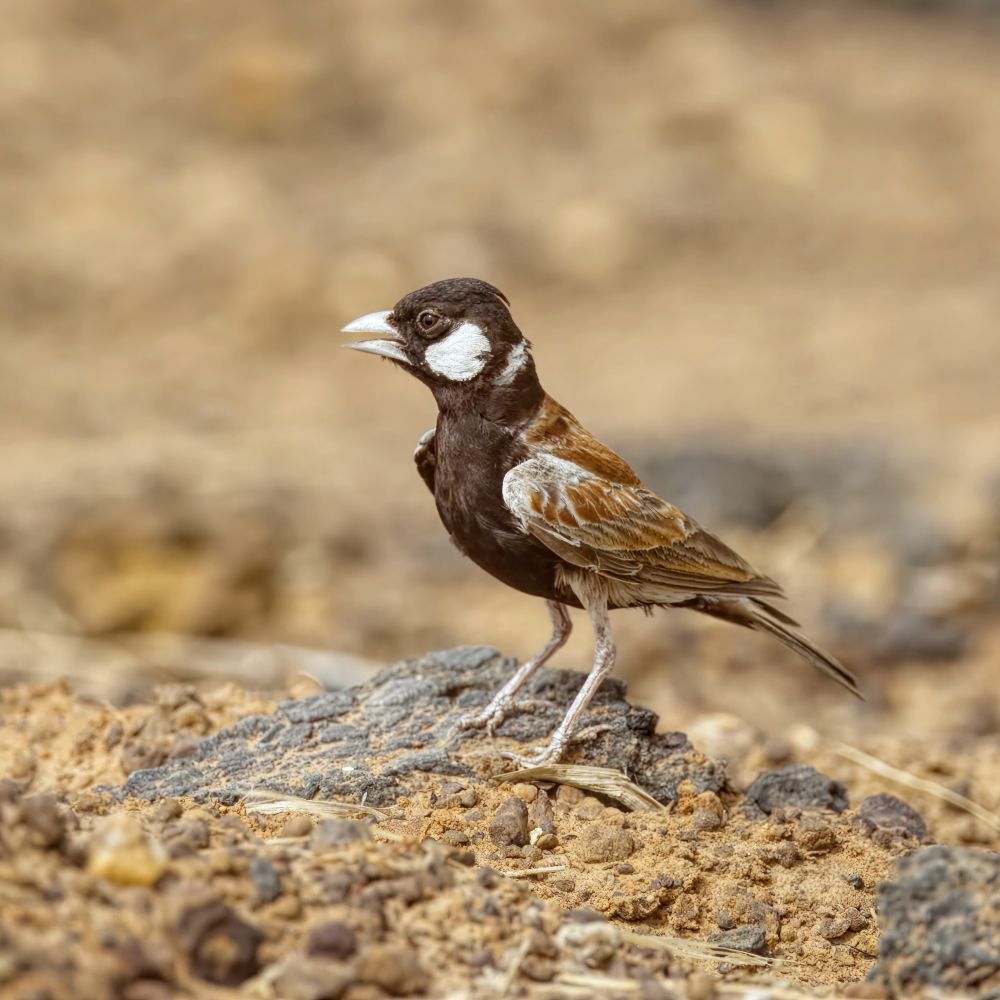
Report by Hans and Lieven, all bird pictures by Lieven De Temmerman.
Download kml file with all gps coordinates.
All sound recordings made during this trip can be found and downloaded (in the future) on xeno-canto. All bird sightings are also available as an eBird trip report and most records are registered with the exact coördinates on observado.org (see accounts of Toon & Lieven).
Thanks to Bram Piot and Ethan Kistler for specific site information, Solomon Jallow and Pap Jobe for organising and taking care of transportation!
INTRODUCTION
This report covers a ‘classic’ itinerary of Senegal, with some extra birding in the Casamance and Gambia. While most birders visit Gambia in order to see West-African / Sahelian bird species, almost all of those are present in Senegal as well, with the addition of:
- some desert species in the North (Golden Nightjar, Sennar Penduline-tit,...),
- range-restricted Sahel / savannah specialties in the South-East (Neumann’s Starling, Mali Firefinch) and
- some West-African forest species that just cross the border in S-Senegal (Turati’s Boubou) up to W-Gambia (Capuchin Babbler).
ITINERARY
We lost one full day which we had to spend in Lisbon. Due to a French air control strike, our first flight had to make a detour avoiding French territories and we missed our connecting flight. Initially, we planned to bird the Djoudj NP, but as all of us had seen Arabian Bustard before and Egyptian Nightjars probably had left their wintering grounds already, we decided to skip this site and keep the extra time for more southern sites. We kept our gained time to catch up with some species in Gambia as they seemed more reliable there. This turned out fine indeed.
Notes on our itinerary
Date | Activity/Night |
10 Mar | arrival Blaise airport Dakar + some hours of sleep in Le Massa mass (Thies) + drive + birding Tip + drive. Saint Louis Hotel Pointe Sud Saint Louis |
11 Mar | birding les Trois Marigots + drive + birding Diatar track. Hotel La Cour du fleuve Podor |
12 Mar | birding Diatar track + drive + birding around Gamadji (Horus swift colony and Foret de N'Dioum Dieri) + drive + birding around Richard Toll (Keur Mbaye and surroundings). Hotel Fort de Dagana |
13 Mar | drive to Popenguine with some roadside birding stops + (night)birding Popenguine. Hotel Villa Serere Popenguine |
14 Mar | birding Popenguine + drive + birding around Toubacouta (Saloum Delta, Sipo island). La Kora Lodge Toubacouta |
15 Mar | birding south of Toubacouta (Reserve de Fathala) + drive (with some birding stops). Hotel Niji Tambacounda |
16 Mar | birding south of Tambacounda + Wassadou. Campement de Wassadou |
17 Mar | birding Wassadou + drive + birding Dindefelo. Hotel chez Mamadou Dindefelo |
18 Mar | birding Dindefelo + drive. Hotel les Cocotiers Kedougou |
19 Mar | drive to Kolda + roadside birding. Hotel Le Relais de Kolda |
20 Mar | drive to Ziguinchor + birding foret de Djibelor + drive to Cap Skirring + birding Casamance Ecoparc. Campement Asseb Diembering |
21 Mar | birding Casamance Ecoparc + drive + birding forest near Mpack + drive + birding near Tendaba. Tendaba camp |
22 Mar | birding near Tendaba + drive + birding Pirang Fish ponds. Sita Joyeh near Farasuto |
23 Mar | birding Farasuto + birding Pirang forest + drive. Hotel Beach Bungalow Kotu beach |
24 Mar | leisurely birding Kotu Creek + departure from Banjul + arrival Brussels. |
Map showing visited sites (red markers) and short stops (yellow markers).
PRACTICALITIES
TRANSPORTATION
We used the services of Gambian birder Solomon Jallow (mobile phone / Whatsapp: +2209921551). Solomon arranged a (Gambian) car with (Gambian) driver. We originally agreed on renting a Mitsubishi 4x4, for a period of 16 days. Solomon suggested upgrading (without cost) to a (newer) Nissan minivan (14-seater), as he thought that car would be more reliable. We mentioned we needed a 4x4 (or at least a car with good ground clearance) for the bad dirt road leading from Kedougou to Dindefelo, and Solomon offered to locally subcontract a 4x4 at his cost. In the end, this arrangement worked out very well. The minibus was very spacious and comfortable for 4 passengers and, importantly, had good air-con. The only downside was that the minibus wasn’t the fastest car on the road (going max. 80-90), but who knows how fast that 4x4 would have gone. We looked at renting our own car, which would have been approx. 30% cheaper, but more time lost at the airport, and with the open jaw (Dakar - Banjul), this would have been too complicated.
Our driver was Pap Jobe (Senegal phone number: 777746823, mobile phone / Whatsapp: +2203563155). He was a very flexible and safe driver, and above all, a very friendly guy. We never felt like he was in the way of our (sometimes crazy) plans, and in fact, having a driver resulted in less worries / stress (e.g. at checkpoints and during random stops along the road) and more rest / sleep for all participants while Pap was driving. Thanks, Pap!
SIM CARD
We bought two local SIM cards as soon as we could in the luggage hall of the airport: Orange and Espresso. Orange clearly outperforms Espresso once outside of the larger cities. Both have very affordable data plans. We heavily made use of the mobile data to search for the latest news on our target species, searching and contacting accommodation, etc
WEATHER & TIMING
In hindsight, March wasn’t the best time to visit the region. We felt that Jan-Feb could have been better. At the time of our visit, it was very hot and dry. As we were already towards the end of the dry season, most waterholes were completely dried out. Bird activity was often low when heat came in and in general birds weren’t too responsive to playback. Moreover, many weavers and especially Whydahs are not in breeding plumage. The most significant bird missed due to non-breeding plumage birds, was Sahel Paradise Whydah, but notwithstanding the searing heat, we did well with regards to most other target birds.
ACCOMMODATION & FOOD
We only pre-booked accommodation for the first night. All other nights, we just used google/booking to find a place to sleep. This way we were very flexible in our itinerary. We encountered no issues finding accommodation, except in Podor where we ended up in the most expensive place (which was nice though). Most places other than the cheaper options had AC and several places had swimming pools. Most hotels did offer food as well, and we took lunch in those hotels while traveling as well. Albeit not always included in the official menu, vegetarian dishes were easy to obtain.
HEALTH & SAFETY
We did not encounter any health or safety issues. Malaria is present, so one has to take prophylaxis pills. Yellow Fever is present as well and a valid vaccination booklet is required when entering the country (they didn’t check). Apart from this, many other annoyances are to be taken into account like: diarrhea, mosquitos, snakes (few seen), scorpions (huge!), land mines (in the Casamance).
VISA
For both Senegal and Gambia, we (and many other countries) didn’t need a visa (a >6-months valid passport was the only requirement). Technically, you need a yellow fever vaccination but this was not checked. If flying out of Gambia, everybody needs to pay a 20 euro (or the same amount in dollar) ‘security’ tax. A retarded way of ripping people off that’s long gone in most countries, but still applicable in Gambia, independent of the airline you are flying with.
MONEY
We each took euros / dollars in cash. At ATM’s, it’s often not possible to withdraw more than 100.000 / 150.000 CFA (Senegal) and we had some trouble finding ATM’s in Gambia out of Banjul, so if your bank is charging for withdrawal, it could be good to take enough cash and change it at the airport (arrival’s hall) where you get more or less the same rate as at an ATM. Not that many hotels / gas stations / restaurants / shops accept payment with credit card, so cash is still the way to go.
LOCAL GUIDES
Our trip was semi-independent as we had no bird guide with us. However, at some sites, we got logistical/birding help from some people.
Saloum Delta | We used the services of a boat man (Abdie Njie, mobile phone: 775366551), both to go and look for the Tiger heron in the mangroves and bring us to the riverine island of Sipo.
Dindefelo | We were welcomed by the representatives of the local protection workgroup and were told we needed a local guide to explore the area. Mamadou ( the owner of the lodge we stayed at) has some bird knowledge and showed us around, although we would have found our way around and the birds ourselves.
Mpak | To visit the forest area behind the small village, we kindly asked permission to the Village Chief. He knows the boubou and showed us around.
Tendaba | To maximize the chances of finding our remaining targets, we used the guiding services of Omar (mobile phone: +220 3866 952). He’s a chill young guide who surely knows his birds and stakeouts. In one morning, we easily connected with our target birds.
Farasuto | Apparently, it was mandatory to have a local guide to bird the Farausto Forest. Hence, we contacted Halima (recommended by Omar) to join us (mobile phone: +220 533 5921). When visiting Bantu Forest, we also got the company of Kawsu (mobile phone: +220 313 6825).
LITERATURE & INFORMATION
Bird identification:
the Birds of Western Africa (Borrow & Demey)
the handy Merlin app by the Cornell Lab, which comes with pictures, maps and sounds for most (not all!) species
Bird sounds:
numerous recordings from the excellent Xeno-Canto sound repository
a great selection is featured in the Merlin app (see above)
a collection of commercial CD’s including: “African Bird Sounds” and “Bird Songs of The Gambia and Senegal’
Logistical & bird info:
Cloudbirders for trip reports
SITE INFO
Here we only list the areas where we birded significantly, i.e. where we searched specifically for some species and did quite some effort to find them. On our trip, we also had many (sometimes random) roadside stops where we did not really ‘fully’ bird and those are left out in this overview.
TIP-MBACKÉ
We arrived late in the evening in Dakar and had a very short sleep before heading to our first birding site. At a seemingly random stop (14.66054, -15.83657) with many coordinates for the Quail-Plover, we headed out scrutinizing the whole area. After some time, we flushed a bird showing its distinctive identity. Soon we refound it on the ground and had great views of an obliging Quail-Plover (14.665757,-15.837057).
Other birds seen on this fairly short roadside stop included a group of very cooperating Cricket Warblers, our first of many Sudan Golden Sparrows, Desert Cisticola and Rufous-tailed Scrub-Robin.
One place worth mentioning is a conveniently located waterhole (15.018286, -16.015388) (that still had some water), known as a stake-out for e.g. Paradise-whydahs (but we didn’t see those).
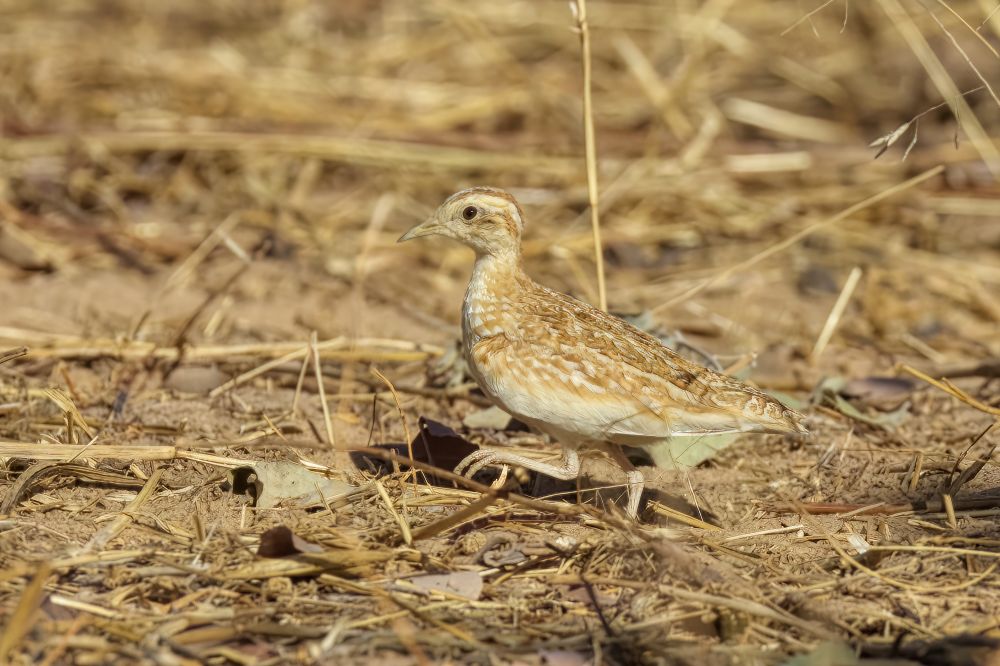
Quail-Plover
SAINT LOUIS AREA (lagunes, Trois Marigots)
In the large vicinity of the coastal city of Saint Louis, we visited two main areas: the coastal laguna(s) and the more inland Trois Marigots.
Before reaching Saint Louis, we made a few stops. The first was near the small fishing village of Degounaye. From the beach (15.832466, -16.517656) we had good views of the small islet with a tern colony. Here we found amongst others our main target: the recently split West African Crested Tern. Unfortunately, we saw many dead birds lying on the islet - clear victims of the raging avian flu... From the same viewing point, we found our second target bird: the pale subspecies monicae of (Mauritanian) Grey Heron. Another stop near the Zebrabar (15.864916, -16.512722) was relaxing and enjoyable as a coffee break, but no extra bird species worth of mention were seen.
Late evening, we used the last birding hour to quickly explore an area near Saint Louis. The marshy area was fairly birdy. Here we quickly found some cooperative River Prinias (16.075072, -16.451186).
The next morning found us in the area called Tres Marigots. Unfortunately, large parts of the area were being developed for agriculture. In this trashed habitat we still managed to find a Savile's Bustard (16.052039,-16.353922) and a single Allen’s Gallinule (16.048734, -16.327080).
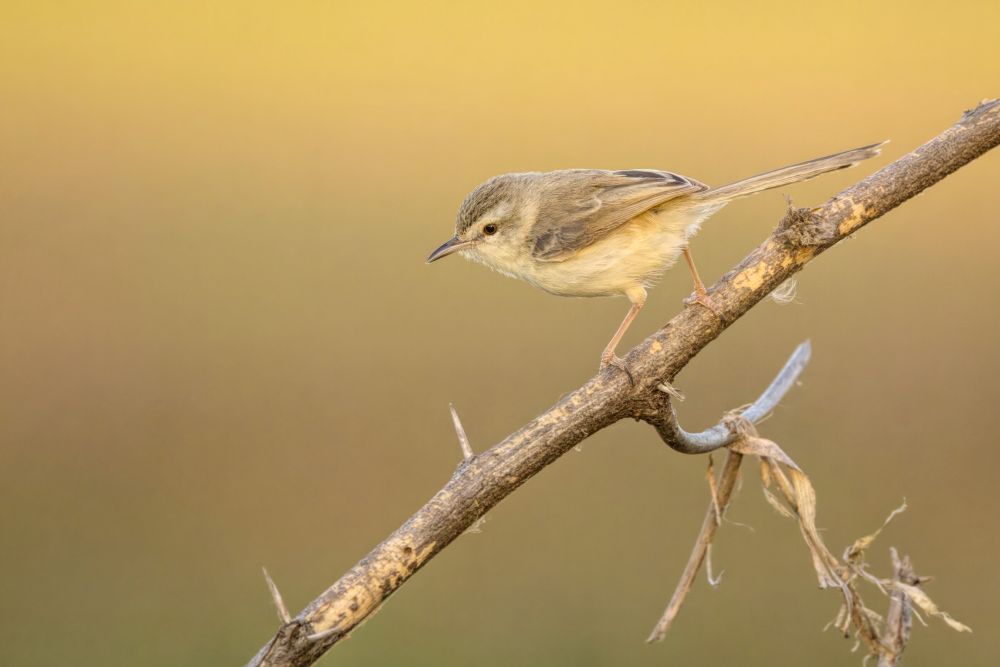
River Prinia
PODOR AREA (Diatar track, Horus swift site, desert forest)
After visiting the Tres Marigots, we headed on a long drive straight towards Podor. When we arrived late in the afternoon, we birded the Diatar Track. It starts at (16.628934, -14.944607). Again, we were shocked by the heavily degraded habitat we encountered. About the whole area was being transformed into an agricultural area with only a few narrow remnants of scrubby habitat. At dusk we were able to find several Long-tailed Nightjars and eventually a hawking Golden Nightjar, all in a somewhat intact habitat patch near the start of the track (16.625988, -14.941179). The next morning (predawn), we went to the same area, found the Golden Nightjar again and followed it until it went for its day roost. This way we had excellent views of this enigmatic bird.
Next, we moved to an area (Mourkadie) east of Podor with a different habitat. We followed a somewhat unclear dirt track (16.519328, -14.757307) that went through some sparsely vegetated red sand soil. Here we found a pair of Fulvous Babblers (16.498424,-14.762829) near the gully. Some more Cricket Warblers and several Atlas Wheatears were present as well.
We made a quick and small detour to a recently discovered breeding colony of Horus Swifts (16.519923,-14.700301) near Gamadji Sare. We instantly were greeted by them, together with some Little Swifts.
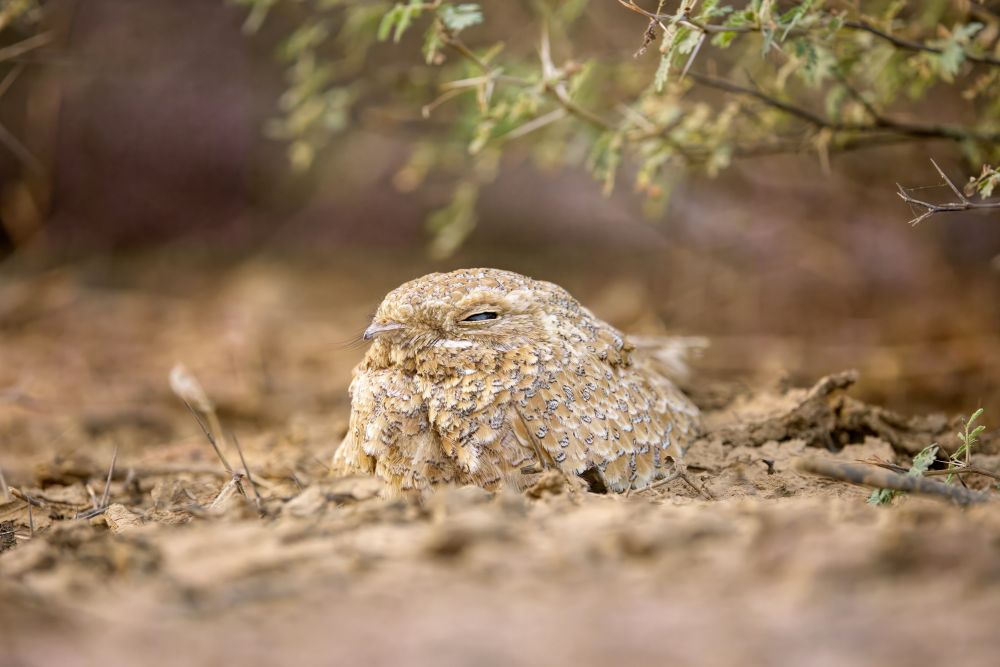
Golden Nightjar
RICHARD TOLL (Penduline site, Airport)
Our first stop was just east of Richard Toll near the settlement of Keur Mbaye (16.473904, -15.610029). In the afternoon heat, we still came across several birds and finally we connected with a pair of Little Grey Woodpeckers (16.470267,-15.609143).
We moved on and made another stop on the other side of the maine road near 16.472854, -15.634171 where we found a pair of Sennar Penduline-Tits in the acacias near the waterhole.
We made several stops along the route (including near the airfield 16.445832, -15.668711) and tried our luck to find the little known Kordofan Lark. We bumped into some (Black-faced) Quailfinches and Chestnut-bellied Sandgrouse, but no Mirafra larks...
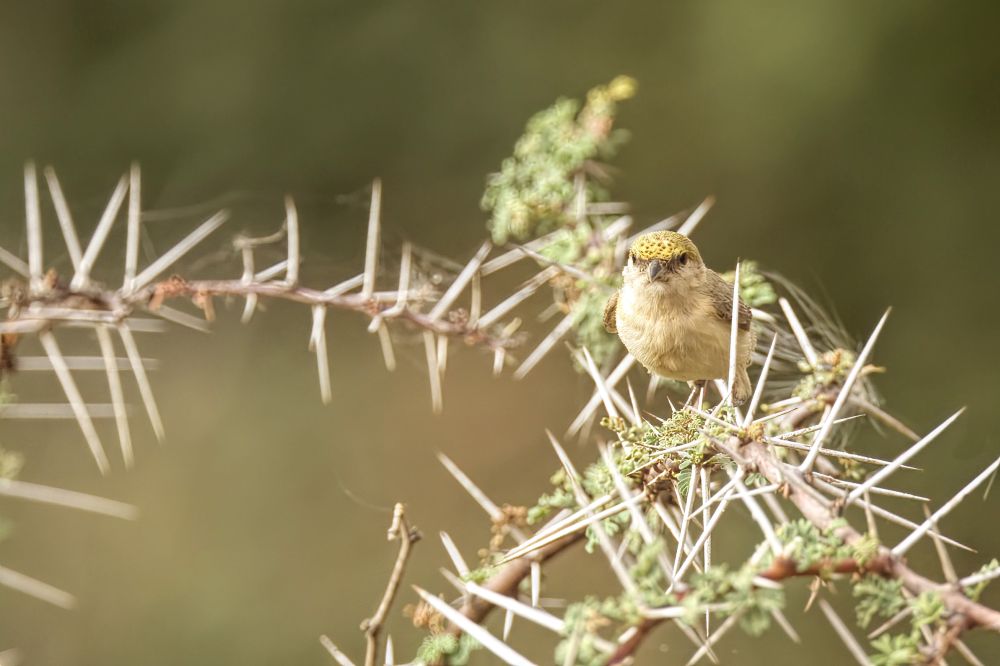
Sennar Penduline-Tit
POPENGUINE
On the way from the North towards Saloum, we made a detour to add another chance to see Standard-winged Nightjar. The outskirts of Popenguine are supposed to be a reliable spot. We tried our luck near 14.556458, -17.105547, both in the evening and early morning before dawn. Despite quite some effort, including wandering along various tracks, we did not see a single nightjar. The general area is being developed and the nearby construction surely didn’t help. Our thermal viewer only revealed a pair of sleeping Common Buttonquails.
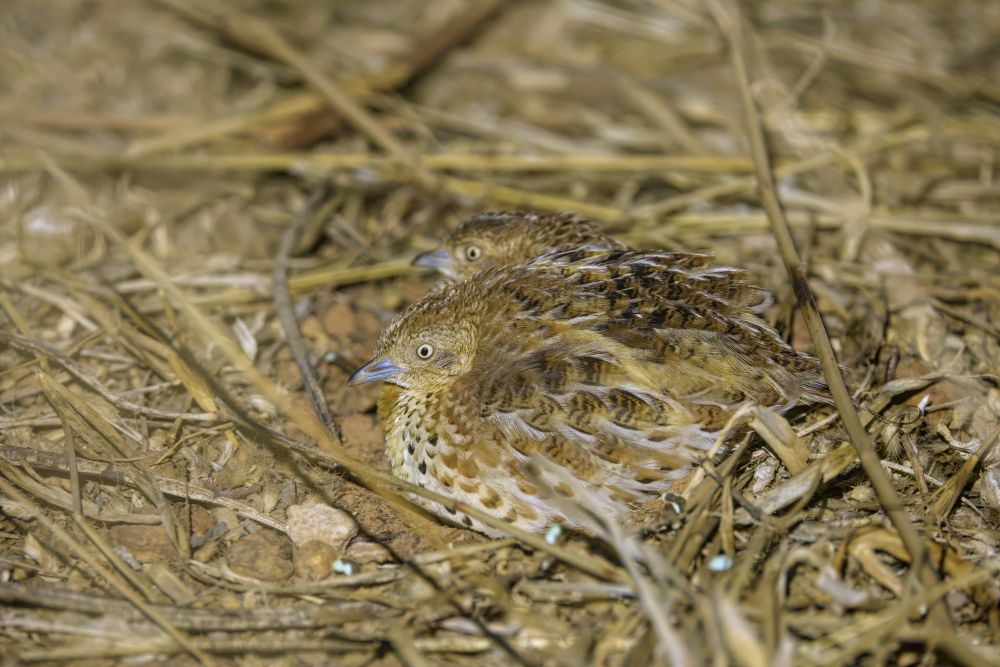
Common Buttonquail
SALOUM DELTA
As we found a single, but cooperative Scissor-tailed Kite en route, we decided to skip the visit to Kousmar Island (14.128589, -16.168856) which is a stakeout for the kite. Late afternoon they flock together and come to roost here, but by the time of our visit there would only have been a handful of birds around. It would have required a canoe trip, so by skipping, we gained half a day.
We arrived around noon in Toubacouta and while having a short coffee break, we contacted a boatsman to take us around. The pier and boats can be found at (13.786019, -16.479648). The rest of the day was spent on a boat trip towards the riverine islet of Sipo. Both on the way up and back we carefully checked the dense overhanging trees/vines and by doing so, we twice saw a White-crested Tiger-Heron, of which the first was near the ‘classic’ spots (13.755609, -16.506660). We birded SW of the village of Sipo (13.750643, -16.508431) but did not see any special birds. Nevertheless, we found day roosting Northern White-faced Scops Owl, our only Four-banded Sandgrouse, several Mottled Spinetails, etc
The next morning was spent some kilometers south of Toubacouta in some forested area. We birded along a track (13.724957, -16.482336) towards the river and later on tried another one, a bit more north (13.731168, -16.481618). We did see Golden-tailed Woodpecker, Swallow-tailed Bee-eater, more Mottled Spinetails, Vieillot's Barbet and a single Long-crested Eagle.
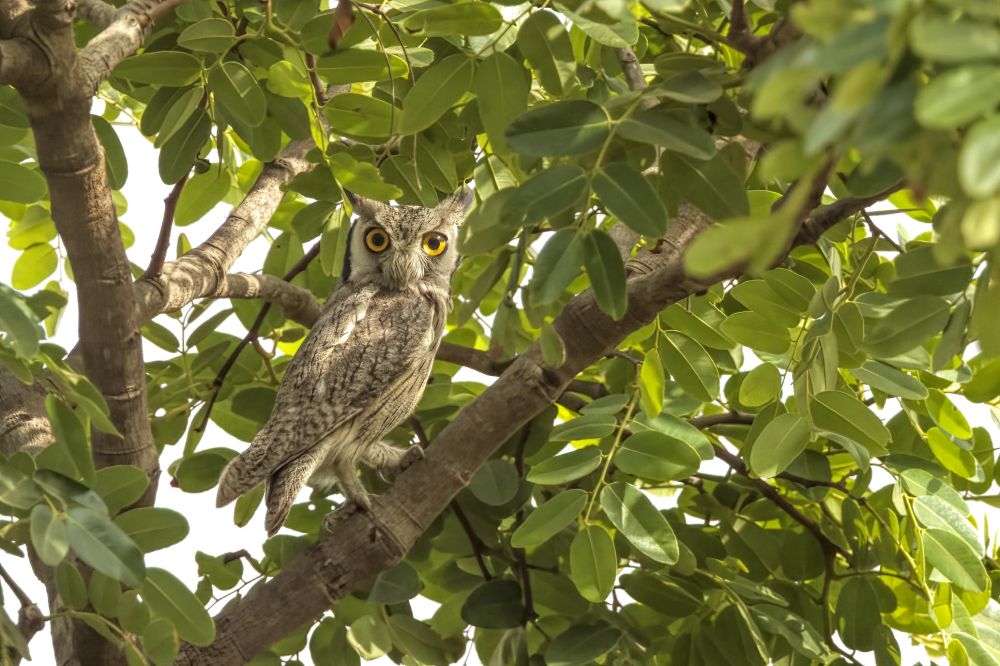
Northern White-faced Scops Owl
WASSADOU CAMP (+ S of Tambacounda)
On the way from Tambacounda to Wassadou, we made some random stops (the whole area around the Foret de Maka should be good for Sahel Paradise-Whydah, roughly this stretch: 13.972847, -15.011782), searching for Sun Lark (found at 13.669011, -13.623298) and Bronze-winged Courser at freshly burned areas (not encountered).
The main attraction in Wassadou is the Gambia river, supporting many highly desired species (from a pan-African perspective). Birding is done right at the camp itself, along a river trail and the entrance road. It was so hot and dry in the region that most birds seemed to be next to the river and little stream.
In the course of one evening and a morning, we walked upstream and saw a single African Finfoot, up to 3 Egyptian Plovers, flocks of Adamawa Turtle-Doves that came to drink (both at 13.347562, -13.364383) and two Pel’s Fishing Owls that came out to forage at dusk (at 13.348128, -13.372135 and the other one more upstream). Next to the camp, right at the river viewpoint, we had two White-backed Night-Herons flying (out at dusk / in at dawn) to their roosting site.
In the riverside lush vegetation of the small creek we encountered 1-2 White-throated Francolins (13.348910, -13.378956), a surprise Rufous Cisticola and, in the more open area, a non-breeding plumage Heuglin’s Masked Weaver. One more bird worth mentioning is a Western Banded Snake-eagle with a freshly caught snake.
Stone Partridge was common along the streams, and we had our first encounter with a Blue-bellied Roller. We didn’t see any White-headed Lapwings (nor Northern Carmine Bee-eaters), as the low water levels prevented the boat from going very far… The camp management told us that walking downstream along the river was not allowed, as this is within the boundaries of the Niokolo-Koba national park.

Western Banded Snake Eagle
DINDEFELO
In the town of Kedougou, we changed our van for a local 4WD and undertook the bumpy ride to Dindefelo. We were happy we did transfer as in our opinion a high-clearance vehicle is recommended, significantly shortening the travel time to Dindefelo.
During a short evening walk to the Dindefelo Waterfalls through some lush forest, we connected with Narina Trogon and our first Neumann’s Starlings, the latter right at the waterfall (12.364927, -12.324950).
The next morning, we walked towards a regularly birded area just North of Dindefelo. On the way, we already encountered our first Mali Firefinches. In the area around (12.397805, -12.308531) we birded North and South from the road, and staked out 2 waterholes that attracted Black-bellied Firefinch, Black-faced Firefinch (common in the area), a pair of Cabanis’s Bunting (a first for Senegal, at the first waterhole: 12.396001, -12.315143) and Mali Firefinch (second waterhole at: 12.398970, -12.308979). Other good birds in this area were Brown-backed Woodpecker, Dorst’s Cisticola, Red-winged Prinia, and Red-necked Falcon.
Leaving Dindefelo at dusk, we encountered a most probable Red-necked Nightjar on the road…
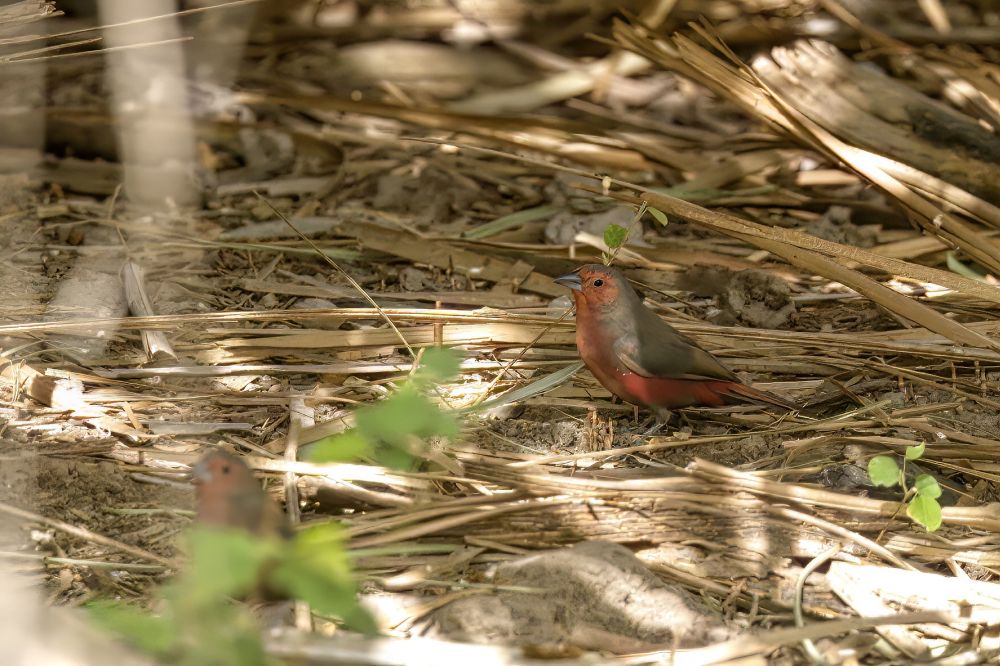
Mali Firefinch
BANDAFASSI CLIFFS
A short morning visit of the Bandafassi cliffs (12.534505, -12.314451) just outside Kedougou, resulted in more Neumann’s Starlings, many Stone Partridges, a single Brown-rumped Bunting and a single Adamawa Turtle-Dove.
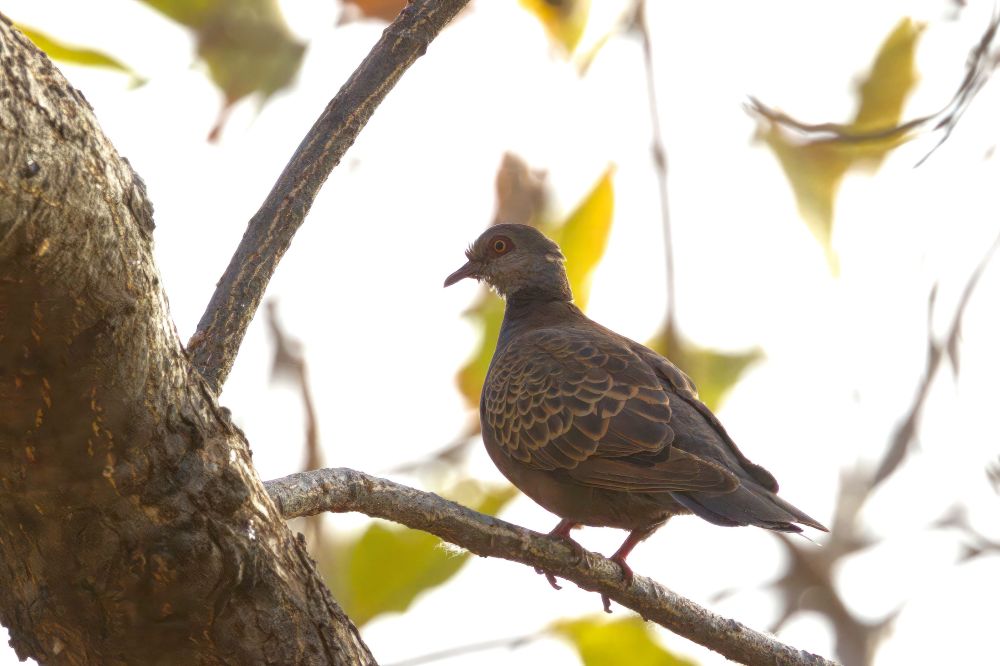
Adamawa Turtle-Dove
ZIGUINCHOR AREA (Forêt de Djibelor, Mpack area)
To get from Kedougou back to Banjul (where we would depart), we opted to take the route through the Casamance. Once considered to be unsafe, it should be fairly fine now. By spending some time here, we would be able to add some new species on our list, that are confined to forested habitat.
Still on our way, we crossed a small wetland area (12.589878, -15.965448) with some hawking swallows and found a few West African Swallows amongst them.
Our first birding site was Forêt de Djibelor, in the outskirts of Ziguinchor. We took the entrance trail at (12.560930, -16.313804) and wandered along several sidetrails. In the parts with higher trees, we found our major target here: several Western Square-tailed Drongos. Other birds seen were Grey-headed Bristlebill and Splendid Sunbird, but we failed to encounter Turati’s Boubou here.
After our visit to the Cap Skirring area, we went to another forest area to search for our remaining target: Turati’s Boubou. We went to a tiny village near Mpak (12.456263, -16.242560) and after talking to the village chief, he insisted on showing us around. It didn’t take too long before we were looking at a very vocal and showy pair of the Turati’s Boubou (12.451014, -16.245951). We kindly thanked the chief and moved on as we had yet another long drive on our program.
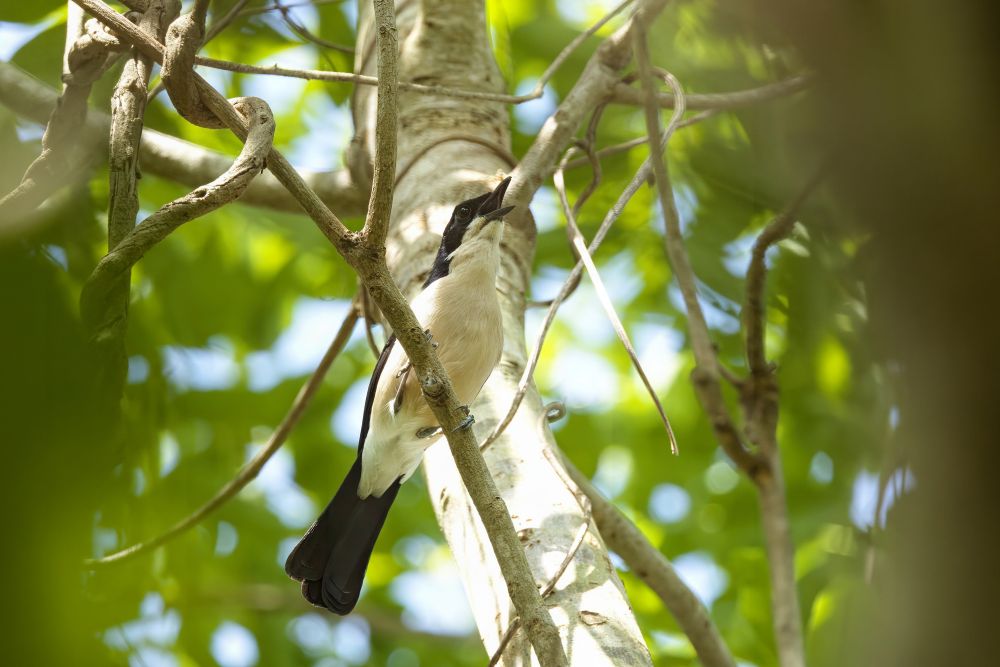
Turati's Boubou
CAP SKIRRING AREA
At the Southwestern coast of Senegal, near the small village of Diembereng, we birded the enjoyable private Casamance Ecopark in order to find the distinctive form of Capuchin Babbler, which favors the dense/tangly forest vegetation. We parked the van at 12.44759, -16.772116 and continued by foot along the main and side trails. We only arrived very late in the afternoon and only two of us were able to get short views of a pair of Capuchin Babblers. On our way out at dusk we heard and saw Black-shouldered Nightjar which has only recently been recorded in Senegal. Luckily, the next morning we all had excellent views of good numbers of Capuchin-Babblers. Other nice birds seen here were African Goshawk, White-spotted Flufftail, and Ahanta Spurfowl amongst others.
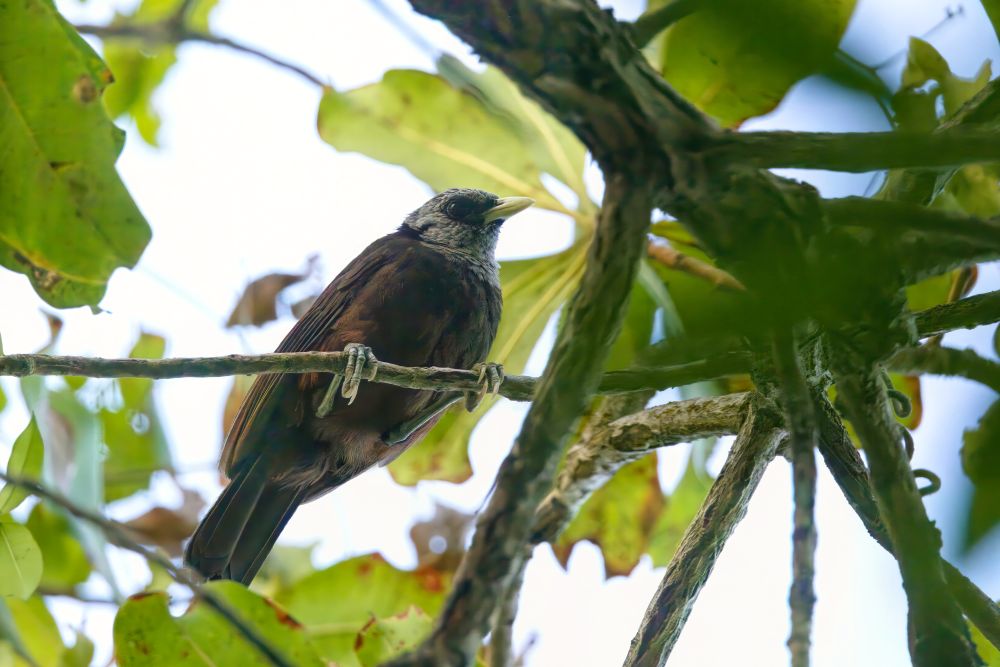
Capuchin Babbler
TENDABA CAMP (Gambia)
Initially, we would not really bird in The Gambia, but we gained some time and decided to spend the extra time in The Gambia to catch up with some missing species. Due to a road closure (construction works) towards the more Western border crossing near Jiboro we were forced to make a long, dusty and bumpy detour in order to enter Gambia through the more Western Digobo border crossing. This way, our first stop was the Tendaba Camp.
In the company of local guide Omar, we made several stops in the preferred habitat of our target birds. Eventually, we did see amongst others: Yellow Penduline-Tit (in the acacia trees at 13.433229,-15.81082), 3 Bronze-winged Coursers (at a recently burnt area around 13.417439,-15.803791), good numbers of Brown-rumped Buntings, 3 White-fronted Black-chats (13.402557,-15.836527) and some Rufous Cisticolas (same area). We did not make a mangrove boat trip here.
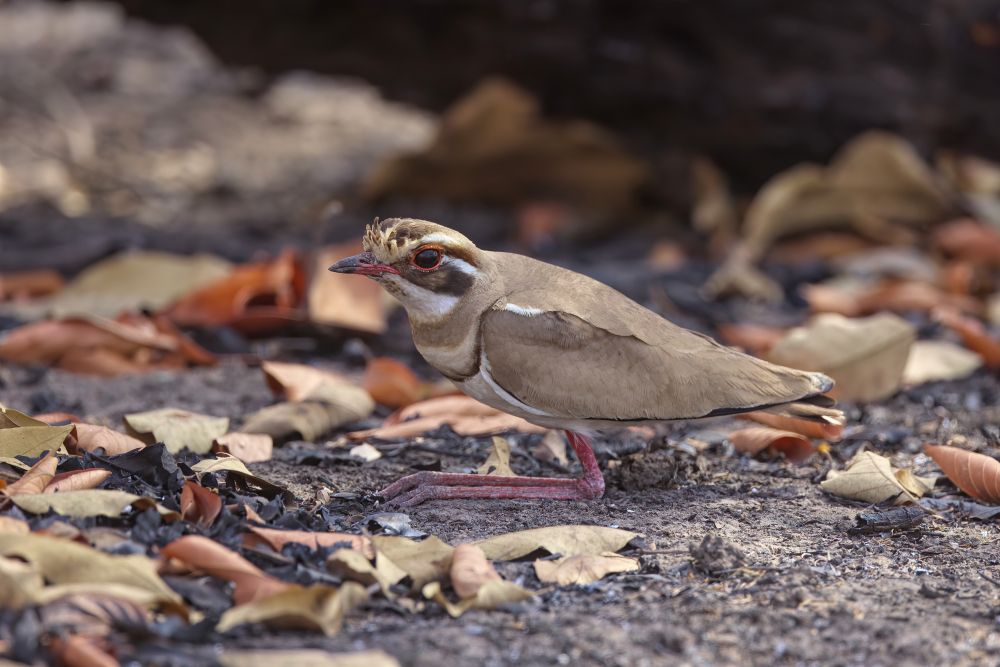
Bronze-winged Courser
FARASUTO & BANTU FOREST (Gambia)
Our second and final destination in The Gambia. As some parts were private, we went in the company of local guide Halima. We made a short evening visit to the Pirang fish ponds (13.274631,-16.527936), but did not see any Pied-winged Swallows here.
In a private garden (13.298627, -16.569644) close to the Farasuto Forest reserve, we took place in a bird hide and after some time we had views of several bird species that came to drink. All three honeyguide species paid a visit of which Spotted Honeyguide was on top of our list. The local caretaker showed us 3 Northern White-faced Owls on their day roost in the very same garden. A stroll into the forest itself did not produce any other good bird except another Spotted Honeyguide.
We moved to the nearby Bantu Forest reserve and after seeing a staked out day roosting Verreaux’s Eagle-owl (13.278985, -16.552016) we went to a more open area and found Pied-winged Swallow (13.283337, -16.548120) between the other swallow species, including our only Fanti Saw-wings for the trip.
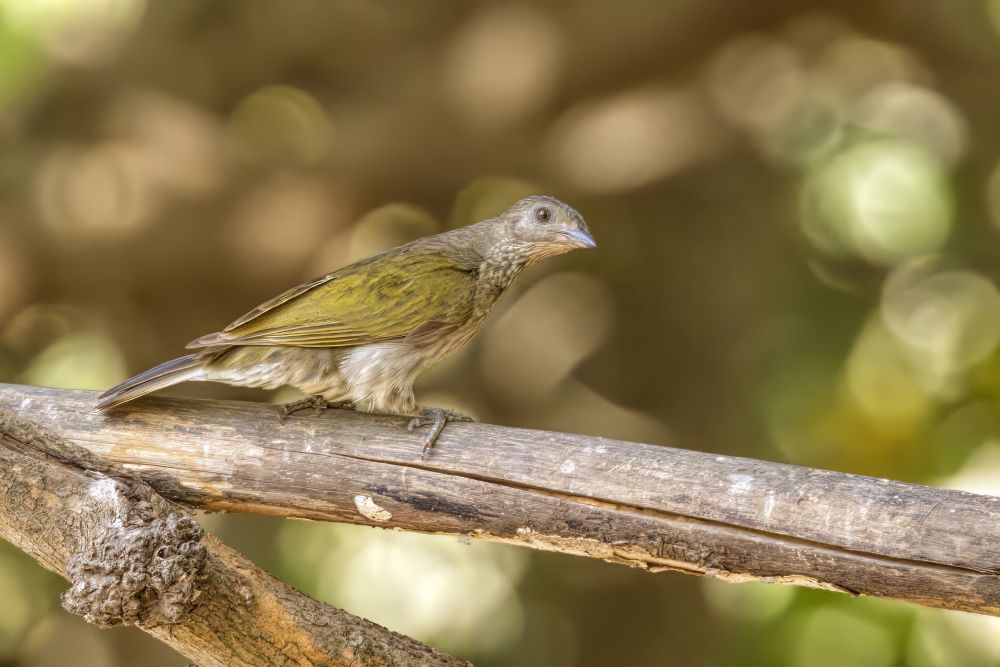
Spotted Honeyguide
KOTU CREEK (Gambia)
After dropping Brecht at the airport, we spent the night near Banjul awaiting our flight the next day. Some late afternoon seawatching only produced some cocktails on the beach. We made a short morning stroll into the nearby Kotu Creek reserve (13.460966, -16.704681) which is a well known birding site, probably for freshly arriving tourists. We might have encountered more bird guides than bird species :-)
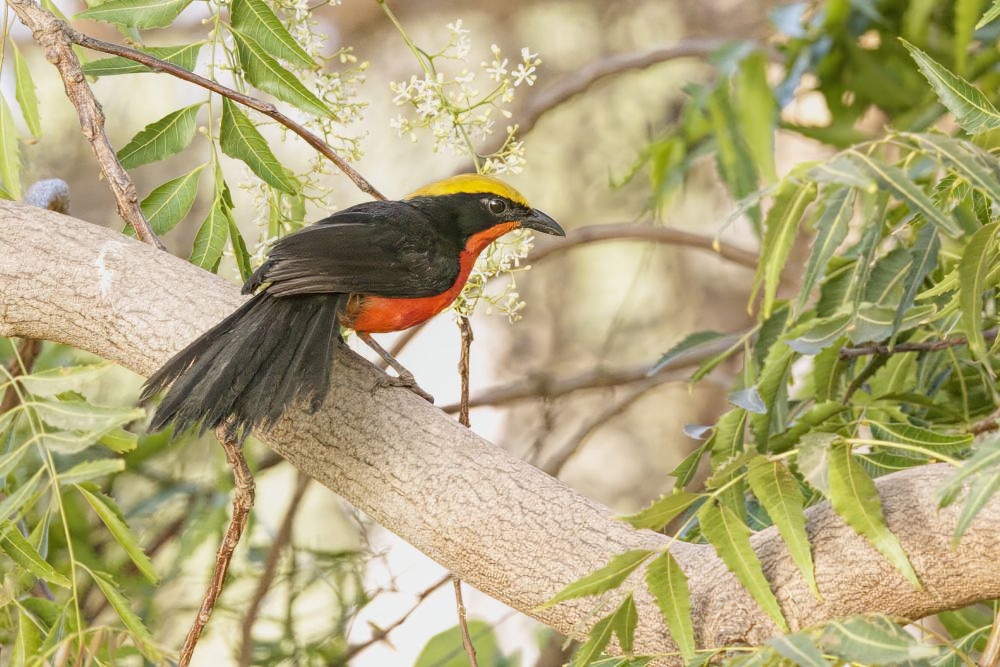
Yellow-crowned Gonolek
Birds not seen
We did not see all possible (semi-)target birds. Some of us had seen several/most of the following species and hence they got less attention. Notable birds that were not seen:
Egyptian Nightjar: we reckoned most of these were already moving towards their breeding grounds, so we simply didn’t try to search for this bird in Djoudj, where day-roosting birds are regularly found in winter.
Standard-winged Nightjar: we gave it a good try near Popenguine, which is deemed to be a reliable site, but we didn’t hear nor see any nightjar.
Lesser Moorhen: seen at scattered sites in Senegal and Gambia, but there weren’t any ‘guaranteed’ sites.
White-crowned Lapwing: Usually seen on a boat ride at Wassadou, but due to the low water levels, they were out of reach.
Lesser Jacana: we looked for this bird around les 3 Marigots, where it is sometimes seen
Beaudouin’s Snake-eagle: we scanned the skies around Tambacouta (mostly while driving) but didn’t see any snake eagle.
Kordofan Lark: this bird has been seen and photographed just North of the abandoned airport at Richard Toll, exactly here: 16.452969, -15.667167. We scanned this area thoroughly during the best part of a morning, but didn’t find any Mirafra larks.
Dybowsky’s Twinspot: this small passerine is often seen around Dindefelo, but we didn’t connect with this bird, either in the fields / scrub around Dindefelo, or at drinking spots along the river towards the Dindefelo falls.
Gosling’s Bunting: we should probably have targeted this bird around Popenguine or scattered sites in Gambia (e.g. Tendaba), but we weren’t specifically aiming at this bird while we still had other priorities…
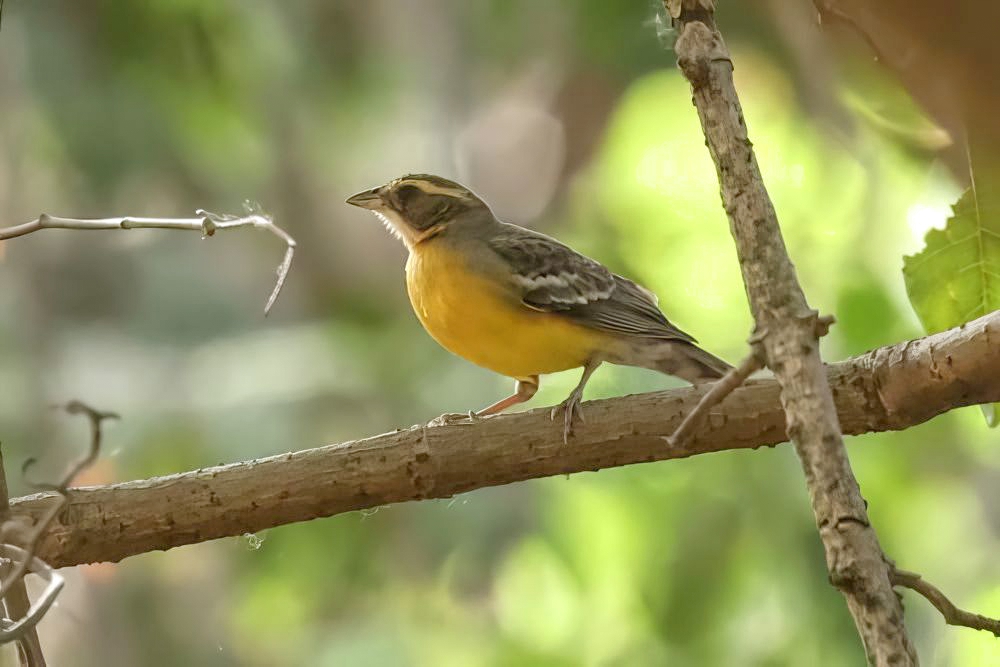
Cabanis’s Bunting - first for Senegal
FULL TRIP LIST
Taxonomy strictly follows IOC 13.1. The list only contains species positively identified by at least one of our group. Birds identified by guides or other people only are not included, presumed species neither...
[340 species]
White-faced Whistling Duck Dendrocygna viduata
Spur-winged Goose Plectropterus gambensis
Knob-billed Duck Sarkidiornis melanotos
Egyptian Goose Alopochen aegyptiaca
African Pygmy Goose Nettapus auritus
Helmeted Guineafowl Numida meleagris
Stone Partridge Ptilopachus petrosus
White-throated Francolin Campocolinus albogularis
Ahanta Spurfowl Pternistis ahantensis
Double-spurred Spurfowl Pternistis bicalcaratus
Golden Nightjar Caprimulgus eximius
Fiery-necked Nightjar Caprimulgus pectoralis
Long-tailed Nightjar Caprimulgus climacurus
Mottled Spinetail Telacanthura ussheri
African Palm Swift Cypsiurus parvus
Little Swift Apus affinis
Horus Swift Apus horus
Western Plantain-eater Crinifer piscator
Violet Turaco Tauraco violaceus
Guinea Turaco Tauraco persa
Savile's Bustard Lophotis savilei
Senegal Coucal Centropus senegalensis
Blue Malkoha Ceuthmochares aereus
Klaas's Cuckoo Chrysococcyx klaas
Chestnut-bellied Sandgrouse Pterocles exustus
Four-banded Sandgrouse Pterocles quadricinctus
Speckled Pigeon Columba guinea
European Turtle Dove Streptopelia turtur
Adamawa Turtle Dove Streptopelia hypopyrrha
Mourning Collared Dove Streptopelia decipiens
Red-eyed Dove Streptopelia semitorquata
Vinaceous Dove Streptopelia vinacea
Laughing Dove Spilopelia senegalensis
Black-billed Wood Dove Turtur abyssinicus
Blue-spotted Wood Dove Turtur afer
Namaqua Dove Oena capensis
Bruce's Green Pigeon Treron waalia
African Green Pigeon Treron calvus
African Finfoot Podica senegalensis
White-spotted Flufftail Sarothrura pulchra
Common Moorhen Gallinula chloropus
Allen's Gallinule Porphyrio alleni
African Swamphen Porphyrio madagascariensis
Black Crake Zapornia flavirostra
Black Crowned Crane Balearica pavonina
Common Buttonquail Turnix sylvaticus
Quail-plover Ortyxelos meiffrenii
Senegal Thick-knee Burhinus senegalensis
Black-winged Stilt Himantopus himantopus
Pied Avocet Recurvirostra avosetta
Spur-winged Lapwing Vanellus spinosus
Black-headed Lapwing Vanellus tectus
African Wattled Lapwing Vanellus senegallus
Grey Plover Pluvialis squatarola
Common Ringed Plover Charadrius hiaticula
Kittlitz's Plover Charadrius pecuarius
Egyptian Plover Pluvianus aegyptius
African Jacana Actophilornis africanus
Eurasian Whimbrel Numenius phaeopus
Eurasian Curlew Numenius arquata
Bar-tailed Godwit Limosa lapponica
Ruff Calidris pugnax
Curlew Sandpiper Calidris ferruginea
Sanderling Calidris alba
Little Stint Calidris minuta
Common Sandpiper Actitis hypoleucos
Green Sandpiper Tringa ochropus
Common Redshank Tringa totanus
Marsh Sandpiper Tringa stagnatilis
Wood Sandpiper Tringa glareola
Common Greenshank Tringa nebularia
Temminck's Courser Cursorius temminckii
Bronze-winged Courser Rhinoptilus chalcopterus
Collared Pratincole Glareola pratincola
Slender-billed Gull Chroicocephalus genei
Grey-headed Gull Chroicocephalus cirrocephalus
Lesser Black-backed Gull Larus fuscus
Gull-billed Tern Gelochelidon nilotica
Caspian Tern Hydroprogne caspia
West African Crested Tern Thalasseus albididorsalis
Sandwich Tern Thalasseus sandvicensis
Little Tern Sternula albifrons
Whiskered Tern Chlidonias hybrida
White-winged Tern Chlidonias leucopterus
Yellow-billed Stork Mycteria ibis
Marabou Stork Leptoptilos crumenifer
African Darter Anhinga rufa
Reed Cormorant Microcarbo africanus
Great Cormorant Phalacrocorax carbo
African Sacred Ibis Threskiornis aethiopicus
Hadada Ibis Bostrychia hagedash
Glossy Ibis Plegadis falcinellus
Eurasian Spoonbill Platalea leucorodia
White-crested Tiger Heron Tigriornis leucolopha
White-backed Night Heron Gorsachius leuconotus
Black-crowned Night Heron Nycticorax nycticorax
Striated Heron Butorides striata
Squacco Heron Ardeola ralloides
Western Cattle Egret Bubulcus ibis
Grey Heron Ardea cinerea
Black-headed Heron Ardea melanocephala
Goliath Heron Ardea goliath
Purple Heron Ardea purpurea
Great Egret Ardea alba
Intermediate Egret Ardea intermedia
Black Heron Egretta ardesiaca
Little Egret Egretta garzetta
Western Reef Heron Egretta gularis
Hamerkop Scopus umbretta
Great White Pelican Pelecanus onocrotalus
Pink-backed Pelican Pelecanus rufescens
Osprey Pandion haliaetus
Scissor-tailed Kite Chelictinia riocourii
African Harrier-Hawk Polyboroides typus
Palm-nut Vulture Gypohierax angolensis
Hooded Vulture Necrosyrtes monachus
White-backed Vulture Gyps africanus
Rüppell's Vulture Gyps rueppelli
Brown Snake Eagle Circaetus cinereus
Western Banded Snake Eagle Circaetus cinerascens
Bateleur Terathopius ecaudatus
Martial Eagle Polemaetus bellicosus
Long-crested Eagle Lophaetus occipitalis
Wahlberg's Eagle Hieraaetus wahlbergi
Booted Eagle Hieraaetus pennatus
Tawny Eagle Aquila rapax
African Hawk-Eagle Aquila spilogaster
Lizard Buzzard Kaupifalco monogrammicus
Gabar Goshawk Micronisus gabar
Dark Chanting Goshawk Melierax metabates
African Goshawk Accipiter tachiro
Shikra Accipiter badius
Western Marsh Harrier Circus aeruginosus
Montagu's Harrier Circus pygargus
Black Kite Milvus migrans
African Fish Eagle Haliaeetus vocifer
Grasshopper Buzzard Butastur rufipennis
Western Barn Owl Tyto alba
Pearl-spotted Owlet Glaucidium perlatum
African Scops Owl Otus senegalensis
Northern White-faced Owl Ptilopsis leucotis
Greyish Eagle-Owl Bubo cinerascens
Verreaux's Eagle-Owl Ketupa lactea
Pel's Fishing Owl Scotopelia peli
Blue-naped Mousebird Urocolius macrourus
Narina Trogon Apaloderma narina
Eurasian Hoopoe Upupa epops
Green Wood Hoopoe Phoeniculus purpureus
Black Scimitarbill Rhinopomastus aterrimus
Abyssinian Ground Hornbill Bucorvus abyssinicus
Western Red-billed Hornbill Tockus kempi
African Pied Hornbill Lophoceros fasciatus
African Grey Hornbill Lophoceros nasutus
Purple Roller Coracias naevius
Abyssinian Roller Coracias abyssinicus
European Roller Coracias garrulus
Blue-bellied Roller Coracias cyanogaster
Broad-billed Roller Eurystomus glaucurus
Grey-headed Kingfisher Halcyon leucocephala
Striped Kingfisher Halcyon chelicuti
Blue-breasted Kingfisher Halcyon malimbica
African Pygmy Kingfisher Ispidina picta
Malachite Kingfisher Corythornis cristatus
Giant Kingfisher Megaceryle maxima
Pied Kingfisher Ceryle rudis
Swallow-tailed Bee-eater Merops hirundineus
Little Bee-eater Merops pusillus
Red-throated Bee-eater Merops bulocki
White-throated Bee-eater Merops albicollis
African Green Bee-eater Merops viridissimus
Blue-cheeked Bee-eater Merops persicus
European Bee-eater Merops apiaster
Yellow-rumped Tinkerbird Pogoniulus bilineatus
Yellow-fronted Tinkerbird Pogoniulus chrysoconus
Vieillot's Barbet Lybius vieilloti
Bearded Barbet Lybius dubius
Lesser Honeyguide Indicator minor
Spotted Honeyguide Indicator maculatus
Greater Honeyguide Indicator indicator
Buff-spotted Woodpecker Pardipicus nivosus
Fine-spotted Woodpecker Campethera punctuligera
Golden-tailed Woodpecker Campethera abingoni
Little Grey Woodpecker Dendropicos elachus
Cardinal Woodpecker Dendropicos fuscescens
African Grey Woodpecker Dendropicos goertae
Brown-backed Woodpecker Dendropicos obsoletus
Lesser Kestrel Falco naumanni
Common Kestrel Falco tinnunculus
Grey Kestrel Falco ardosiaceus
Red-necked Falcon Falco chicquera
African Hobby Falco cuvierii
Lanner Falcon Falco biarmicus
Senegal Parrot Poicephalus senegalus
Rose-ringed Parakeet Psittacula krameri
Senegal Batis Batis senegalensis
Brown-throated Wattle-eye Platysteira cyanea
Grey-headed Bushshrike Malaconotus blanchoti
Orange-breasted Bushshrike Chlorophoneus sulfureopectus
Black-crowned Tchagra Tchagra senegalus
Northern Puffback Dryoscopus gambensis
Turati's Boubou Laniarius turatii
Yellow-crowned Gonolek Laniarius barbarus
Brubru Nilaus afer
White-crested Helmetshrike Prionops plumatus
Yellow-billed Shrike Corvinella corvina
Great Grey Shrike Lanius excubitor
Woodchat Shrike Lanius senator
African Golden Oriole Oriolus auratus
Glossy-backed Drongo Dicrurus divaricatus
Western Square-tailed Drongo Dicrurus occidentalis
Red-bellied Paradise Flycatcher Terpsiphone rufiventer
African Paradise Flycatcher Terpsiphone viridis
Piapiac Ptilostomus afer
Pied Crow Corvus albus
African Blue Flycatcher Elminia longicauda
White-shouldered Black Tit Melaniparus guineensis
Sennar Penduline Tit Anthoscopus punctifrons
Yellow Penduline Tit Anthoscopus parvulus
Black-crowned Sparrow-Lark Eremopterix nigriceps
Chestnut-backed Sparrow-Lark Eremopterix leucotis
Horsfield's Bush Lark Mirafra javanica
Sun Lark Galerida modesta
Crested Lark Galerida cristata
Greater Short-toed Lark Calandrella brachydactyla
Grey-headed Bristlebill Bleda canicapillus
Little Greenbul Eurillas virens
Red-tailed Leaflove Phyllastrephus scandens
Common Bulbul Pycnonotus barbatus
Fanti Saw-wing Psalidoprocne obscura
Sand Martin Riparia riparia
Pied-winged Swallow Hirundo leucosoma
Wire-tailed Swallow Hirundo smithii
Barn Swallow Hirundo rustica
Red-chested Swallow Hirundo lucida
Common House Martin Delichon urbicum
Red-breasted Swallow Cecropis semirufa
Mosque Swallow Cecropis senegalensis
Red-rumped Swallow Cecropis daurica
Northern Crombec Sylvietta brachyura
Green Hylia Hylia prasina
Western Bonelli's Warbler Phylloscopus bonelli
Common Chiffchaff Phylloscopus collybita
Greater Swamp Warbler Acrocephalus rufescens
Sedge Warbler Acrocephalus schoenobaenus
Common Reed Warbler Acrocephalus scirpaceus
Eastern Olivaceous Warbler Iduna pallida
Western Olivaceous Warbler Iduna opaca
Melodious Warbler Hippolais polyglotta
Winding Cisticola Cisticola marginatus
Dorst's Cisticola Cisticola guinea
Rufous Cisticola Cisticola rufus
Zitting Cisticola Cisticola juncidis
Desert Cisticola Cisticola aridulus
Tawny-flanked Prinia Prinia subflava
River Prinia Prinia fluviatilis
Red-winged Prinia Prinia erythroptera
Cricket Warbler Spiloptila clamans
Yellow-breasted Apalis Apalis flavida
Oriole Warbler Hypergerus atriceps
Green-backed Camaroptera Camaroptera brachyura
Yellow-bellied Eremomela Eremomela icteropygialis
Senegal Eremomela Eremomela pusilla
Eurasian Blackcap Sylvia atricapilla
Western Subalpine Warbler Curruca iberiae
Common Whitethroat Curruca communis
Northern Yellow White-eye Zosterops senegalensis
Fulvous Babbler Argya fulva
Capuchin Babbler Turdoides atripennis
Brown Babbler Turdoides plebejus
Blackcap Babbler Turdoides reinwardtii
Greater Blue-eared Starling Lamprotornis chalybaeus
Bronze-tailed Starling Lamprotornis chalcurus
Purple Starling Lamprotornis purpureus
Long-tailed Glossy Starling Lamprotornis caudatus
Chestnut-bellied Starling Lamprotornis pulcher
Violet-backed Starling Cinnyricinclus leucogaster
Neumann's Starling Onychognathus neumanni
Yellow-billed Oxpecker Buphagus africanus
African Thrush Turdus pelios
Black Scrub Robin Cercotrichas podobe
Rufous-tailed Scrub Robin Cercotrichas galactotes
Northern Black Flycatcher Melaenornis edolioides
Swamp Flycatcher Muscicapa aquatica
Snowy-crowned Robin-Chat Cossypha niveicapilla
White-crowned Robin-Chat Cossypha albicapillus
European Pied Flycatcher Ficedula hypoleuca
Common Redstart Phoenicurus phoenicurus
Mocking Cliff Chat Thamnolaea cinnamomeiventris
Anteater Chat Myrmecocichla aethiops
Northern Wheatear Oenanthe oenanthe
Atlas Wheatear Oenanthe seebohmi
Western Black-eared Wheatear Oenanthe hispanica
White-fronted Black Chat Oenanthe albifrons
Familiar Chat Oenanthe familiaris
Western Violet-backed Sunbird Anthreptes longuemarei
Pygmy Sunbird Hedydipna platura
Olive Sunbird Cyanomitra olivacea
Scarlet-chested Sunbird Chalcomitra senegalensis
Beautiful Sunbird Cinnyris pulchellus
Splendid Sunbird Cinnyris coccinigastrus
Variable Sunbird Cinnyris venustus
Copper Sunbird Cinnyris cupreus
Sahel Bush Sparrow Gymnoris dentata
Northern Grey-headed Sparrow Passer griseus
House Sparrow Passer domesticus
Sudan Golden Sparrow Passer luteus
White-billed Buffalo Weaver Bubalornis albirostris
Little Weaver Ploceus luteolus
Olive-naped Weaver Ploceus brachypterus
Heuglin's Masked Weaver Ploceus heuglini
Vitelline Masked Weaver Ploceus vitellinus
Village Weaver Ploceus cucullatus
Black-headed Weaver Ploceus melanocephalus
Red-billed Quelea Quelea quelea
Bronze Mannikin Spermestes cucullata
Magpie Mannikin Spermestes fringilloides
African Silverbill Euodice cantans
Lavender Waxbill Glaucestrilda caerulescens
Orange-cheeked Waxbill Estrilda melpoda
Black-rumped Waxbill Estrilda troglodytes
Quailfinch Ortygospiza atricollis
Cut-throat Finch Amadina fasciata
Orange-breasted Waxbill Amandava subflava
Red-cheeked Cordon-bleu Uraeginthus bengalus
Red-winged Pytilia Pytilia phoenicoptera
Red-billed Firefinch Lagonosticta senegala
Mali Firefinch Lagonosticta virata
Black-bellied Firefinch Lagonosticta rara
Black-faced Firefinch Lagonosticta larvata
Village Indigobird Vidua chalybeata
Exclamatory Paradise Whydah Vidua interjecta
Western Yellow Wagtail Motacilla flava
White Wagtail Motacilla alba
Plain-backed Pipit Anthus leucophrys
Tree Pipit Anthus trivialis
White-rumped Seedeater Crithagra leucopygia
Yellow-fronted Canary Crithagra mozambica
Brown-rumped Bunting Emberiza affinis
Cabanis's Bunting Emberiza cabanisi
|